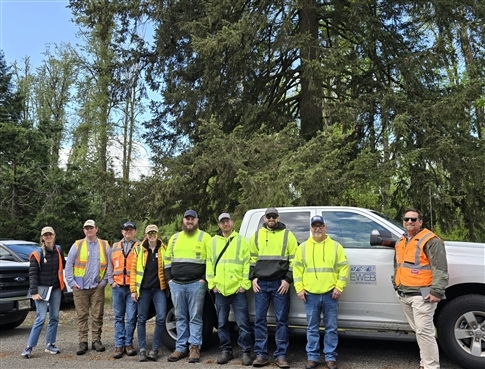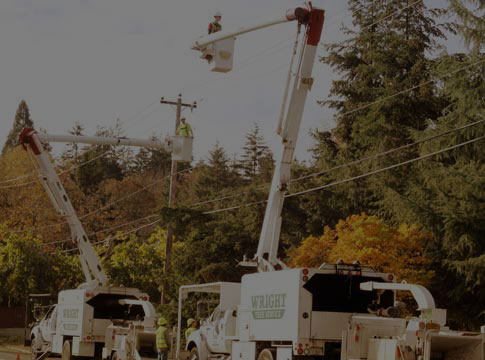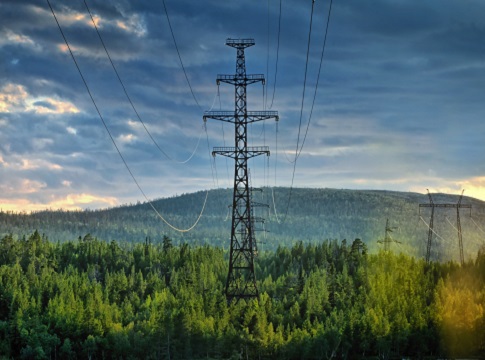Related News
Related News
-
EWEB secures $2.5 billion of reliable, affordable, carbon-free energy for customers
The new contract with EWEB’s largest energy supplier, the Bonneville Power Administration, forms the foundation of a diverse energy portfolio.
Find Out More -
Women in STEM: Meet the Hydro Project Engineer Building Habitat for Salmon
EWEB Engineer Associate Val Chang found her way to the McKenzie River from Los Angeles, inspired by heritage trips to the waters of Taiwan and key mentors along the way.
Find Out More -
Public Power Week Poster Contest Winners 2025
The results are in! View the winning posters from EWEB's 2025 Public Power Week Poster Contest.
Find Out More -
EWEB Hometown Heroes compete internationally
Out of 290 teams from 14 different countries, EWEB's Lineman Rodeo team places in the top third of competitors.
Find Out More -
Sustainability Snapshot - Celebrating Energy Efficiency Projects in the Community
Sustainability Snapshops highlight impactful projects completed by EWEB's Customer Solutions department, as a way to celebrate the meaningful work happening behind the scenes.
Find Out More -
Let's Talk Turkey. Is your family ready for winter?
We're heading into the holidays, but that also means snow, ice, and not-so-nice weather might be in the forecast. Here are some tips to prepare in advance.
Find Out More -
Vote for your favorite Public Power Week Posters
The top five submittals will receive awards. Help us pick the winners.
Find Out More -
EWEB Partners with Eugene School District 4J to Celebrate New Kennedy Middle School Emergency Water Station Site
Hundreds of attendees practiced filling up water containers at Saturday's demonstration event.
Find Out More -
Electric Projects underway in North & South Eugene
Underground lines and disaster-resilient power poles are part of EWEB’s infrastructure upgrade near Eugene’s largest natural resource area.
Find Out More -
The Bonneville Power Administration Rate Change and Your EWEB Bill
BPA’s finalized rate increase is smaller than projected, and EWEB’s pass-through adjustment effective October 1, 2025 will now be 2.7% for residential customers—down from the anticipated 4%.
Find Out More -
Join the Pledge to Prepare
When you think about getting ready for an emergency, you probably have questions. You aren't alone. Preparing for emergencies can be overwhelming, which is why EWEB has put together a 12-month program to help you and your family get two weeks ready.
Find Out More -
You can’t predict the next disaster, but you can prepare
The earthquake lasted less than a minute. But now the power’s out. The tap runs dry. Cell service is spotty. Would you be ready?
Find Out More -
EWEB completes helicopter installation of salmon habitat features
EWEB adds downed trees and 2,000 tons of gravel to the Uupper McKenzie River below Tamolitch Falls to improve spawning habitat.
Find Out More -
Court rules in favor of EWEB in Carmen-Smith litigation
The U.S. District Court in Eugene has granted EWEB's motion to dismiss a lawsuit brought under the Endangered Species Act pertaining to fish passage at EWEB’s Trail Bridge Dam. The favorable ruling clears the way for EWEB to continue advancing towards implementation of permanent fish passage at the dam.
Find Out More -
EWEB proposes modified plan for permanent fish passage at Trail Bridge Dam
After eight months of extensive collaboration and analysis with scientific experts at two federal regulatory agencies, EWEB is proposing an improved plan to build permanent fish passage facilities at Trail Bridge Dam on the McKenzie River.
Find Out More - Show More
EWEB invests in satellite-based forestry analytics for vegetation management
May 30, 2024 • By Robyn Smith, EWEB Communications

Vegetation management is an essential tool in EWEB's power outage mitigation toolbox.
As we witnessed during the back-to-back ice storms in January, hazardous falling trees and snapped branches coming down on power lines create prolonged outages and unsafe working conditions during severe weather events.
That’s why, each year, crews trim over 500 overhead 'line miles' of vegetation to minimize falling trees and branches, avoid outages and increase the electric system's reliability.
EWEB maintains over 1,300 miles of overhead transmission and distribution lines. To aid crews in identifying hazardous vegetation growth in a sometimes heavily forested service territory, EWEB is utilizing a new satellite-based forestry analytics software called Overstory.
"Using remote sensing data, we help utilities optimize resources, mitigate risk, and strategically direct the vegetation management that matters most," said Overstory Customer Success Manager Kathryn Morse.
The first year's analysis (conducted in the fall of 2023) focused on areas with denser tree coverage, like south Eugene and McKenzie River service areas. The satellite imagery captures overhead power lines with nearby tree canopies and uses technology to quickly identify areas that could benefit from additional vegetation management. It also creates a heat map of places with high tree mortality—these 'hazard' trees are more likely to fall into powerlines during severe weather.
EWEB's Resiliency Program Manager Jeannine Parisi said, "The goal is to efficiently target tree-trimming in areas of highest risk and develop an action plan to address hazard trees that pose a fall-in risk to our overhead lines. It's especially helpful for terrain that's hard to access for visual inspection."

How the vegetation intelligence works:
- It creates vegetation data from remote sensing sources (detects tree height, health, and species).
- It combines data that matters most for EWEB (pole and line location, wildfire risk maps, trim specifications, terrain, and slope maps).
- It helps build a data-driven vegetation management program (management cycle prioritization, hazard trees, encroachment, reliability forecasts, and contractor audits).

In May, the Overstory team joined EWEB's vegetation crew in the field to review the first-year data analysis. In the field, the team easily located some of the riskiest areas.
"By looking at our risk matrix, utilities can identify the amount of vegetation nearby, both horizontally and vertically, to conductors, which helps us accurately project vegetation-related outages," said Morse.

Last year, Overstory satellite imaging analyzed vegetation across 180 ‘line miles' and found that EWEB's current vegetation management practices are very effective at maintaining clearance, with just a few areas that might need additional trimming work.
"We just captured new satellite imagery to update the analysis, particularly given the amount of tree damage from the ice storm," said Parisi. Overstory will analyze about 425 ‘line miles' of EWEB's electric system this year.
This forward-thinking vegetation management tool is just one example of how EWEB proactively invests today to prepare for a resilient tomorrow.
Related Programs
Trees are a major cause of power outages in the Eugene area. To help prevent tree-related outages we proactively prune trees to help keep our equipment clear.



